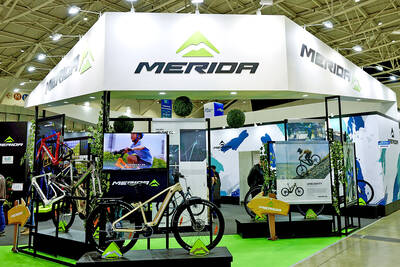A mega-port project on the north Kenyan coast conceived in the 1970s may finally be gaining traction based on commercial oil finds in Uganda and Kenya, but it needs more financing to compete with a Chinese-backed port in Tanzania and other rivals.
Initial work has started on a mangrove coast near the ancient Arab trading post of Lamu that could in a few years be a bustling container port and crude terminal, creating an export hub for fast-growing east African states and their oil.
However, Kenya must shore up regional commitment for the US$25.5 billion Lamu Port-South Sudan-Ethiopia Transport (LAPSSET) plan that by 2030 envisages a port, new roads, a railway and pipeline.

Photo: Reuters
It must also overcome environmental worries and make a clearer economic case to avoid creating one more African white elephant.
The prize will be to bolster Kenya’s primacy as east Africa’s trade gateway and capitalize on a bonanza from one of the world’s hottest undeveloped oil provinces, where exports from Uganda and Kenya alone could reach 500,000 barrels per day.
Experts say the Lamu port and transport links are viable, if not on such a huge scale. Some South African banks are watching closely, but emerging markets now face tougher times raising cash and no big donors, such as China, have thrown their full weight behind the plan. Other pitfalls also lurk.
POLITICAL OBSTACLE
“The big obstacle is really a political one and making sure all the discussions that need to happen, happen,” said Clare Allenson, an analyst at the Eurasia Group consultancy, referring to a region where rivalries can run deep even within the east African trade bloc.
“This is a very grandiose scheme and there are ample examples of this type of thing never coming off the ground [in Africa],” she said.
Initially predicated on convincing South Sudan to switch its oil exports to Lamu from the regularly disrupted pipeline it now uses via Sudan, the Kenyan scheme has found a new raison d’etre.
First, Uganda agreed to ship its future oil output through a pipeline to Lamu. Then last month, British explorer Tullow Oil increased Kenya’s oil reserve estimates and said east Africa’s biggest economy could start oil exports by 2016.
“We are now talking about three oil sources, up from one oil source when the studies were previously done,” LAPSSET chief executive Silvester Kasuku said.
However, Kenya’s virtual monopoly on regional trade through its now-congested Mombasa port has often rankled its neighbors.
South Sudan has suggested that a new pipeline, probably warranted only if it finds more oil to replace mature fields, could run through Ethiopia to a port in Djibouti. Uganda lately backed a Kenyan route, after mulling one via Tanzania.
However, Kenya and Uganda may be enough to get the oil terminal going. Nairobi is confident it can make an economic case for a Uganda-Kenya pipeline costing an estimated US$2.5 billion to US$5 billion, made costlier because Uganda’s waxy oil means it must be heated to enable flow. A spur could then go to South Sudan.
“We are talking about economies of scale here ... which gives greater investment credence to the project, raises the project’s profitability and de-risks a lot of other factors which were associated with one single oil source,” Kasuku said.
The desire swiftly to monetize oil in the ground may also be focusing minds in the region, where many are still in poverty.
“East Africa is getting its act together in terms of starting to realize that if they do things together, they can move faster,” oil and gas consultant Mwendia Nyaga said.
A compacted dirt road cut through the mangroves is the first sign of work at the site, where a Chinese firm has a US$470 million contract for Lamu port’s first three berths.
Those are the first of 32 planned berths at a port estimated to cost US$5.5 billion. Further funds will be needed for the planned roads and railway linking South Sudan and Ethiopia, a land-locked nation of 90 million people that is growing swiftly.
However, financing is merely trickling in. Battling a big budget deficit, Kenya allocated only about US$48 million to the project this fiscal year. China’s involvement with Lamu pales against its backing for Tanzania’s US$10 billion Bagamoyo port plan.
The World Bank, African Development Bank and the EU are funding roads linking Kenya with South Sudan and Ethiopia. Though this could help the Lamu project, these donors and concessionary lenders are not directly funding LAPSSET.
On the international markets, funding has become trickier as the US looks set to rein in its loose monetary policy, hiking interest rates for emerging market borrowers. Still, some South African banks and others are keeping an eye on the project.
ECONOMIC CASE
“Given the ultimate size of the project, there will be considerable space for all lenders with African debt capacity to play [a role] in the funding,” said Mike Peo, head of infrastructure at Nedbank Capital, the investment banking arm of South Africa’s fourth-largest bank, Nedbank.
South Africa’s Rand Merchant Bank also said it was interested, while London-based emerging markets specialist Standard Chartered said it was watching progress.
The Development Bank of Southern Africa has said it is keen to be a lead arranger for funding. Kasuku said the bank could offer as much as US$1.5 billion to LAPSSET.
Some say Kenya must make a clearer case for creating a new container port over expanding and upgrading Mombasa.
“I don’t see how container shipment through Lamu port can be the business case for the port,” said Steve Felder, east Africa managing director of Danish shipping and oil group A.P. Moller-Maersk.
On the ground, the government faces worries the new port and surrounding development will harm delicate coastal vegetation and marine life, and could overwhelm the popular tourist destination of Lamu.
Residents fear a land grab by a wealthy elite as the project gets under way at the expense of locals, a perennial complaint in Kenya. Local officials insist they will not let this happen.
“We have learnt from the Mombasa port experience where everything goes to the central government,” Governor Issa Timamy said at a Lamu meeting where residents complained about seizures. “We are not willing to repeat that mistake in Lamu.”
Additional reporting by Helen Nyambura-Mwaura

Merida Industry Co (美利達) has seen signs of recovery in the US and European markets this year, as customers are gradually depleting their inventories, the bicycle maker told shareholders yesterday. Given robust growth in new orders at its Taiwanese factory, coupled with its subsidiaries’ improving performance, Merida said it remains confident about the bicycle market’s prospects and expects steady growth in its core business this year. CAUTION ON CHINA However, the company must handle the Chinese market with great caution, as sales of road bikes there have declined significantly, affecting its revenue and profitability, Merida said in a statement, adding that it would

MARKET LEADERSHIP: Investors are flocking to Nvidia, drawn by the company’s long-term fundamntals, dominant position in the AI sector, and pricing and margin power Two years after Nvidia Corp made history by becoming the first chipmaker to achieve a US$1 trillion market capitalization, an even more remarkable milestone is within its grasp: becoming the first company to reach US$4 trillion. After the emergence of China’s DeepSeek (深度求索) sent the stock plunging earlier this year and stoked concerns that outlays on artificial intelligence (AI) infrastructure were set to slow, Nvidia shares have rallied back to a record. The company’s biggest customers remain full steam ahead on spending, much of which is flowing to its computing systems. Microsoft Corp, Meta Platforms Inc, Amazon.com Inc and Alphabet Inc are

RISING: Strong exports, and life insurance companies’ efforts to manage currency risks indicates the NT dollar would eventually pass the 29 level, an expert said The New Taiwan dollar yesterday rallied to its strongest in three years amid inflows to the nation’s stock market and broad-based weakness in the US dollar. Exporter sales of the US currency and a repatriation of funds from local asset managers also played a role, said two traders, who asked not to be identified as they were not authorized to speak publicly. State-owned banks were seen buying the greenback yesterday, but only at a moderate scale, the traders said. The local currency gained 0.77 percent, outperforming almost all of its Asian peers, to close at NT$29.165 per US dollar in Taipei trading yesterday. The

The US overtaking China as Taiwan’s top export destination could boost industrial development and wage growth, given the US is a high-income economy, an economist said yesterday. However, Taiwan still needs to diversify its export markets due to the unpredictability of US President Donald Trump’s administration, said Chiou Jiunn-rong (邱俊榮), an economics professor at National Central University. Taiwan’s exports soared to a record US$51.74 billion last month, driven by strong demand for artificial intelligence (AI) products and continued orders, with information and communication technology (ICT) and audio/video products leading all sectors. The US reclaimed its position as Taiwan’s top export market, accounting for